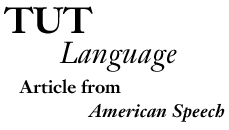


|

|
|
|
My introduction to TUT Language began when I happened to be the only child
at home on a day that my mother’s sister came to visit. While they
were talking, I could hear recognizable sounds, but not words.
Later, when I asked my mother about the sounds, she told me that what
they had been speaking was called TUT Language. She spoke the sounds My mother told me she had learned TUT Language from her mother, who said it was a method devised by some African slaves in America to teach each other to spell — therefore, to read — at a time when reading by slaves was against the law, and the punishment, if they were caught, was severe. She told me that perhaps some slaves made a language game from the sounds they heard repeated by the owners’ children who were being taught to read. So, it may have been those alphabet sounds that were memorized and, with a few additions, called TUT Language. In 1969 I was told by my aunt that her father (who could read and write English) had referred to TUT Language as a “disguised language” that could have got him killed; thus, as a grown man he refused to speak it. The word TUT may have originated from the word talk.
GLORIA MCILWAIN
American Speech Journal |
|
| Copyright © by Gloria E. McIlwain, All rights reserved |